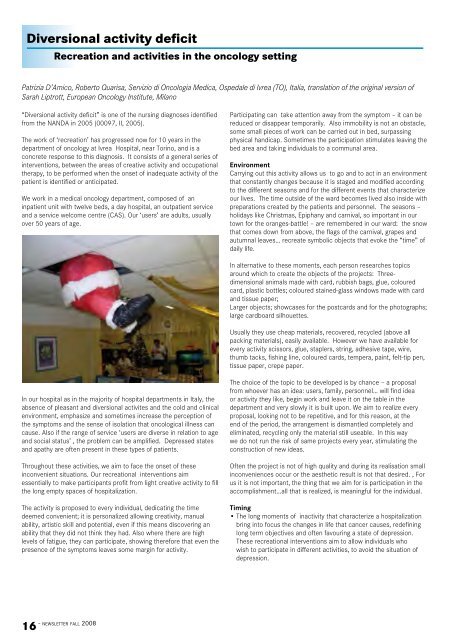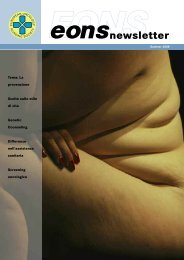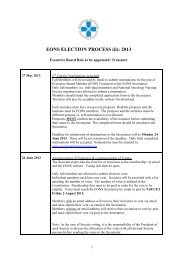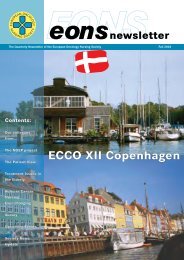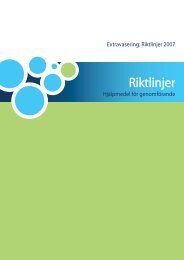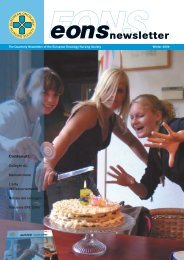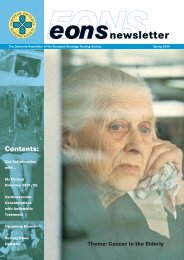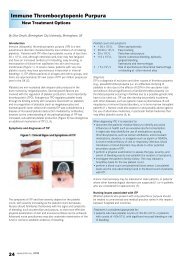English - the European Oncology Nursing Society
English - the European Oncology Nursing Society
English - the European Oncology Nursing Society
- No tags were found...
Create successful ePaper yourself
Turn your PDF publications into a flip-book with our unique Google optimized e-Paper software.
Diversional activity deficitRecreation and activities in <strong>the</strong> oncology settingPatrizia D’Amico, Roberto Quarisa, Servizio di Oncologia Medica, Ospedale di Ivrea (TO), Italia, translation of <strong>the</strong> original version ofSarah Liptrott, <strong>European</strong> <strong>Oncology</strong> Institute, Milano“Diversional activity deficit” is one of <strong>the</strong> nursing diagnoses identifiedfrom <strong>the</strong> NANDA in 2005 (00097, II, 2005).The work of ‘recreation’ has progressed now for 10 years in <strong>the</strong>department of oncology at Ivrea Hospital, near Torino, and is aconcrete response to this diagnosis. It consists of a general series ofinterventions, between <strong>the</strong> areas of creative activity and occupational<strong>the</strong>rapy, to be performed when <strong>the</strong> onset of inadequate activity of <strong>the</strong>patient is identified or anticipated.We work in a medical oncology department, composed of aninpatient unit with twelve beds, a day hospital, an outpatient serviceand a service welcome centre (CAS). Our ‘users’ are adults, usuallyover 50 years of age.Participating can take attention away from <strong>the</strong> symptom – it can bereduced or disappear temporarily. Also immobility is not an obstacle,some small pieces of work can be carried out in bed, surpassingphysical handicap. Sometimes <strong>the</strong> participation stimulates leaving <strong>the</strong>bed area and taking individuals to a communal area.EnvironmentCarrying out this activity allows us to go and to act in an environmentthat constantly changes because it is staged and modified accordingto <strong>the</strong> different seasons and for <strong>the</strong> different events that characterizeour lives. The time outside of <strong>the</strong> ward becomes lived also inside withpreparations created by <strong>the</strong> patients and personnel. The seasons –holidays like Christmas, Epiphany and carnival, so important in ourtown for <strong>the</strong> oranges-battle! – are remembered in our ward: <strong>the</strong> snowthat comes down from above, <strong>the</strong> flags of <strong>the</strong> carnival, grapes andautumnal leaves… recreate symbolic objects that evoke <strong>the</strong> “time” ofdaily life.In alternative to <strong>the</strong>se moments, each person researches topicsaround which to create <strong>the</strong> objects of <strong>the</strong> projects: Threedimensionalanimals made with card, rubbish bags, glue, colouredcard, plastic bottles; coloured stained-glass windows made with cardand tissue paper;Larger objects; showcases for <strong>the</strong> postcards and for <strong>the</strong> photographs;large cardboard silhouettes.Usually <strong>the</strong>y use cheap materials, recovered, recycled (above allpacking materials), easily available. However we have available forevery activity scissors, glue, staplers, string, adhesive tape, wire,thumb tacks, fishing line, coloured cards, tempera, paint, felt-tip pen,tissue paper, crepe paper.In our hospital as in <strong>the</strong> majority of hospital departments in Italy, <strong>the</strong>absence of pleasant and diversional activites and <strong>the</strong> cold and clinicalenvironment, emphasize and sometimes increase <strong>the</strong> perception of<strong>the</strong> symptoms and <strong>the</strong> sense of isolation that oncological illness cancause. Also if <strong>the</strong> range of service ‘users are diverse in relation to ageand social status’ , <strong>the</strong> problem can be amplified. Depressed statesand apathy are often present in <strong>the</strong>se types of patients.Throughout <strong>the</strong>se activities, we aim to face <strong>the</strong> onset of <strong>the</strong>seinconvenient situations. Our recreational interventions aimessentially to make participants profit from light creative activity to fill<strong>the</strong> long empty spaces of hospitalization.The activity is proposed to every individual, dedicating <strong>the</strong> timedeemed convenient; it is personalized allowing creativity, manualability, artistic skill and potential, even if this means discovering anability that <strong>the</strong>y did not think <strong>the</strong>y had. Also where <strong>the</strong>re are highlevels of fatigue, <strong>the</strong>y can participate, showing <strong>the</strong>refore that even <strong>the</strong>presence of <strong>the</strong> symptoms leaves some margin for activity.The choice of <strong>the</strong> topic to be developed is by chance – a proposalfrom whoever has an idea: users, family, personnel… will find ideaor activity <strong>the</strong>y like, begin work and leave it on <strong>the</strong> table in <strong>the</strong>department and very slowly it is built upon. We aim to realize everyproposal, looking not to be repetitive, and for this reason, at <strong>the</strong>end of <strong>the</strong> period, <strong>the</strong> arrangement is dismantled completely andeliminated, recycling only <strong>the</strong> material still useable. In this waywe do not run <strong>the</strong> risk of same projects every year, stimulating <strong>the</strong>construction of new ideas.Often <strong>the</strong> project is not of high quality and during its realisation smallinconveniences occur or <strong>the</strong> aes<strong>the</strong>tic result is not that desired. , Forus it is not important, <strong>the</strong> thing that we aim for is participation in <strong>the</strong>accomplishment…all that is realized, is meaningful for <strong>the</strong> individual.Timing• The long moments of inactivity that characterize a hospitalizationbring into focus <strong>the</strong> changes in life that cancer causes, redefininglong term objectives and often favouring a state of depression.These recreational interventions aim to allow individuals whowish to participate in different activities, to avoid <strong>the</strong> situation ofdepression.- newsletter fall 200816


